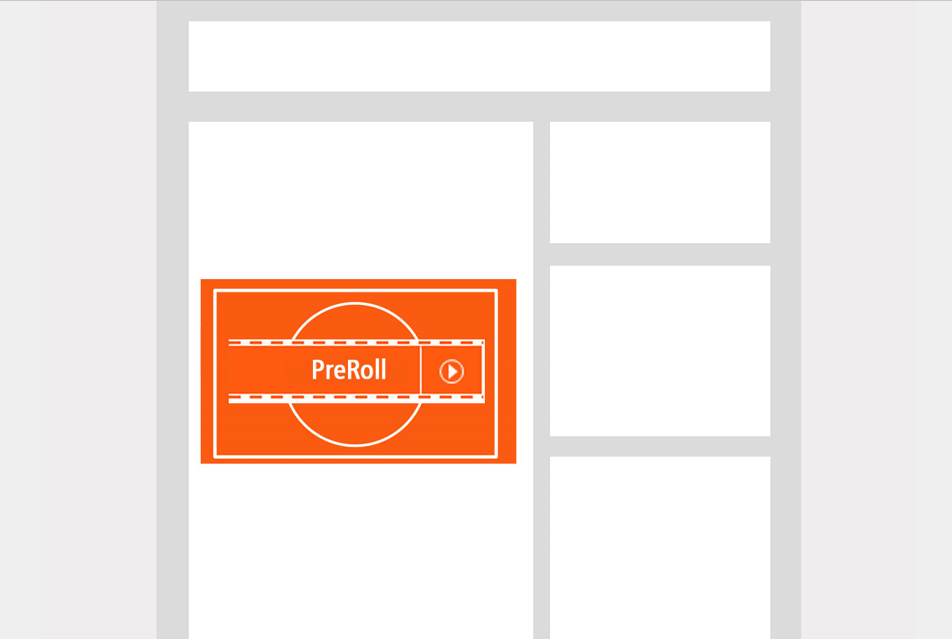Video Instream (Pre-Roll, Mid-Roll, Post-Roll, Bumper Ad)

Video Instream (Pre-Roll, Mid-Roll, Post-Roll, Bumper Ad)
InStream Video Ads are divided into Linear Video Ads (PreRolls, MidRolls, PostRolls, Bumper Ad) and Non-Linear Video Ads (Overlay).
A linear video ad takes up the user's full attention. It is placed before, between or after the video content and runs linearly, i.e. the ad never runs at the same time as the video content. A distinction is made between pre-roll, mid-roll, post-roll and bumper ads:
- PreRoll: Advertising video is played directly before the website content. As soon as the user clicks on the desired content, your video ad is played automatically. If desired, a countdown shows when the editorial content requested by the user will start. Advertising effectiveness is therefore guaranteed.
- MidRoll: Content video is interrupted and advertising video is played, then content continues.
- PostRoll: Advertising video is played directly after the content video.
- Bumper Ad: The advertising video is played before the website content in the same way as PreRoll. The difference to the PreRoll is that the Bumper Ad only has a maximum spot length of 6 seconds.
Specifications
We are happy to encode your video into all relevant advertising formats. All we need is your source file.
The source file must have the following properties:
- Container: MP4 (.mp4)
- Bitrates: At least 2,500kbps. Conversion into different bitrate variants for the various device types (desktop, MEW, APP, CTV) is carried out by STRÖER
- Frame rate: 25 frames / second
- max. file size: 20 MB / for Multiscreen & Mobile campaigns please additionally provide a 10 MB spot
- Spot length: Bumper ad max. 6 seconds Pre-roll, mid-roll, post-roll non-skippable: max 30 seconds
- Audio format: MPEG-1 Audio Layer 3 or MPEG-2 Audio Layer 3
- Audio Bitrates: preferably 128 kbps for WEB, for CTV 256 kbps
- Audio sample rate: preferably 48 kHz, 16 bit, stereo
- Tracking Pixel: Additional tracking pixels to be included must be delivered secured (https)
- Content: The basic material should start immediately in the first frame; black images at the beginning or end of the advert are not permitted.
Protocol: allowed are VAST 4.0, VAST 4.0 Wrapper, VAST 3.0, VAST 3.0 Wrapper, VAST 2.0
Video container: MP4 (.mp4)
Codec: h.264
Dimension:
- For delivery multiscreen 3 MediaFiles with preferably 480x270 (Mobile APP, MEW) and 640x360 (Tablet, Desktop) and 1280x720 (Desktop / CTV).
- For delivery on individual devices (e.g. with booked device targeting), the respective dimensions for the corresponding device are sufficient (see above)
Bitrates:
- For delivery multiscreen 3 MediaFiles with preferably min. 400 kbps to max. 1,200 kbps (MEW / mobile app) and min. 600 kbps to max. 2,000 kbps (desktop) and min. 2,500 kbps to max. 6,000 kbps (CTV)
- For delivery on individual devices (e.g. with booked device targeting), the respective bit rate for the corresponding device is sufficient (see above)
max. file size:
- 4 MB for Web (Desktop, Mobile Web, App),
- no restrictions for
Spot length:
- Bumper ad max 6 sec.
- Pre-roll, mid-roll and post-roll non-skippable max 30 sec.
- Skippable videos must be delivered as VPAID with included skip button (skippable after 5 seconds).
- Frame rate: 25 frames / second
Audio format: MPEG-1 Audio Layer 3 or MPEG-2 Audio Layer 3
- Audio bit rates: preferably 128 kbps, for CTV 256 kbps
- Audio sample rate: preferably 48 kHz, 16 bit, stereo
Tracking Pixel:
- All tracking pixels and contained elements must be delivered securely (https)
- Tracking pixels that use user-related data (e.g. IP address) must be GDPR or TCF2.2 compliant
API frameworks:
- VPAID 2.0 (Javascript) is possible for delivery on the web - here the media files contained must fulfil the following requirements. The use of VPAID media files is generally not possible for delivery on mobile apps and CTV.
- OMID 1.0: Is supported for web environments and may be included in the VAST response. On inventories that do not yet support Open Measurement SDK, measurement via OMID Vendor is not yet possible, but the creative can be delivered.
- SIMID 1.1 is currently not yet supported
Bitrate-adaptive streaming:
- The delivery of HTTP Live Streaming (HLS) media files is only permitted for delivery to CTV devices
- For multiscreen delivery, the HLS file must not be listed in the first node of the MediaFiles
- Filename extensions: .m3u, .m3u8
- MediaFile Type: application/x-mpegurl
- Delivery: Physical or as a wrapper URL (only for hosting in Google AdManager or YouTube)
- Container: MP4 (.mp4)
- Dimension: preferably 1280x720
- Maximum. Length: Bumper Ad 6- sec, Pre-Roll non skippable up to 20- sec, Pre-Roll skippable 30- sec.
- Frame rate: 25 frames / second
- Audio characteristics: 48 kHz, 16 bit, stereo
- Tracking pixel: Only Google-certified providers possible: developers.google.com/ads-data-hub/resources/adh-vendors
- Content: The base material should start immediately in the first frame; black images at the beginning or end of the advert are not permitted.
- Special features We Are Era Companion Banner:
- Dimensions: 300x60
- File weight: 150 kb
- Delivery: only physical image files (no VAST): .gif, .jpeg, .png
- Creatives with a partially black or white background must have a visible border in a contrasting colour.
A delivery deadline of at least 5 working days before the delivery date of the advertising material applies here.
The following information should be included in the mail for the advertising material delivery:
Customer name, campaign name, campaign period, advertising medium, allocation of advertising material for individual placements and contact person in case of queries.
Please also note the general information on the delivery of advertising material in the Ströer global specifications.
Please note that if ad content arrives late or does not fulfil the technical specifications, Ströer Digital Media reserves the right to postpone the campaign by the number of days that the ad content arrived late in order to achieve the contractually agreed objectives.
Last update: 23/02/2024


